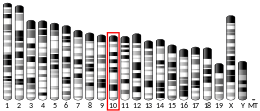TAAR2
Trace amine-associated receptor 2 (TAAR2), formerly known as G protein-coupled receptor 58 (GPR58), is a protein that in humans is encoded by the TAAR2 gene.[5][6][7][8] TAAR2 is coexpressed with Gα proteins;[8] however, as of February 2017, its signal transduction mechanisms have not been determined.[8]
| TAAR2 | |||||||||||||||||||||||||
|---|---|---|---|---|---|---|---|---|---|---|---|---|---|---|---|---|---|---|---|---|---|---|---|---|---|
| Identifiers | |||||||||||||||||||||||||
| Aliases | TAAR2, GPR58, taR-2, trace amine associated receptor 2, trace amine associated receptor 2 (gene/pseudogene) | ||||||||||||||||||||||||
| External IDs | OMIM: 604849 MGI: 2685071 HomoloGene: 110760 GeneCards: TAAR2 | ||||||||||||||||||||||||
| |||||||||||||||||||||||||
| |||||||||||||||||||||||||
| |||||||||||||||||||||||||
| |||||||||||||||||||||||||
| Orthologs | |||||||||||||||||||||||||
| Species | Human | Mouse | |||||||||||||||||||||||
| Entrez | |||||||||||||||||||||||||
| Ensembl | |||||||||||||||||||||||||
| UniProt | |||||||||||||||||||||||||
| RefSeq (mRNA) | |||||||||||||||||||||||||
| RefSeq (protein) | |||||||||||||||||||||||||
| Location (UCSC) | Chr 6: 132.62 – 132.62 Mb | Chr 10: 23.94 – 23.94 Mb | |||||||||||||||||||||||
| PubMed search | [3] | [4] | |||||||||||||||||||||||
| Wikidata | |||||||||||||||||||||||||
| |||||||||||||||||||||||||
Human TAAR2 (hTAAR2) is expressed in the cerebellum, olfactory sensory neurons in the olfactory epithelium, and leukocytes (i.e., white blood cells), among other tissues.[9][10] hTAAR1 and hTAAR2 are both required for white blood cell activation by trace amines in granulocytes.[11]
A single nucleotide polymorphism nonsense mutation of the TAAR2 gene is associated with schizophrenia.[8][9] TAAR2 is a probable pseudogene in 10–15% of Asians as a result of a polymorphism that produces a premature stop codon at amino acid 168.[8]
3‐iodo‐thyronamine(T1AM) was identified as a nonselective ligand for TAAR2.[10]
References
- GRCh38: Ensembl release 89: ENSG00000146378 - Ensembl, May 2017
- GRCm38: Ensembl release 89: ENSMUSG00000059763 - Ensembl, May 2017
- "Human PubMed Reference:". National Center for Biotechnology Information, U.S. National Library of Medicine.
- "Mouse PubMed Reference:". National Center for Biotechnology Information, U.S. National Library of Medicine.
- Lee DK, Lynch KR, Nguyen T, Im DS, Cheng R, Saldivia VR, et al. (February 2000). "Cloning and characterization of additional members of the G protein-coupled receptor family". Biochimica et Biophysica Acta (BBA) - Gene Structure and Expression. 1490 (3): 311–23. doi:10.1016/s0167-4781(99)00241-9. PMID 10684976.
- Lindemann L, Ebeling M, Kratochwil NA, Bunzow JR, Grandy DK, Hoener MC (March 2005). "Trace amine-associated receptors form structurally and functionally distinct subfamilies of novel G protein-coupled receptors". Genomics. 85 (3): 372–85. doi:10.1016/j.ygeno.2004.11.010. PMID 15718104.
- "Entrez Gene: TAAR2 trace amine associated receptor 2".
- Davenport AP, Alexander S, Sharman JL, Pawson AJ, Benson HE, Monaghan AE, Liew WC, Mpamhanga C, Battey J, Benya RV, Jensen RT, Karnik S, Kostenis E, Spindel E, Storjohann L, Tirupula K, Bonner TI, Neubig R, Pin JP, Spedding M, Harmar A (25 June 2015). "TAAR2". IUPHAR/BPS Guide to PHARMACOLOGY. International Union of Basic and Clinical Pharmacology. Retrieved 22 February 2017.
- Khan MZ, Nawaz W (October 2016). "The emerging roles of human trace amines and human trace amine-associated receptors (hTAARs) in central nervous system". Biomedicine & Pharmacotherapy. 83: 439–449. doi:10.1016/j.biopha.2016.07.002. PMID 27424325.
- Cichero E, Tonelli M (May 2017). "New insights into the structure of the trace amine-associated receptor 2: Homology modelling studies exploring the binding mode of 3-iodothyronamine". Chemical Biology & Drug Design. 89 (5): 790–796. doi:10.1111/cbdd.12903. PMID 27863038.
- Babusyte A, Kotthoff M, Fiedler J, Krautwurst D (March 2013). "Biogenic amines activate blood leukocytes via trace amine-associated receptors TAAR1 and TAAR2". Journal of Leukocyte Biology. 93 (3): 387–94. doi:10.1189/jlb.0912433. PMID 23315425.
This article incorporates text from the United States National Library of Medicine, which is in the public domain.




